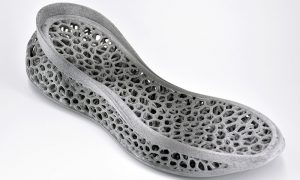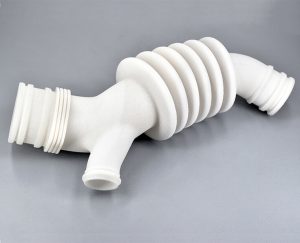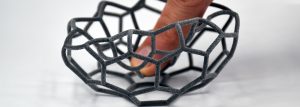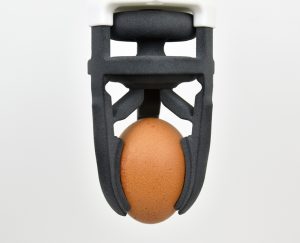What are the advantages of 3D printing TPU?
Combining the advantages of 3D printing and TPU can open up new opportunities for your business. Implement flexibility in both your manufacturing process and your products.
- Create flexible prototypes
Additive manufacturing is an efficient prototyping method. You need to create a 3D model of your project to get it 3D printed. No molding is required! This technique is perfect for developing different iterations of the same product.
Additive Manufacturing is fast and produces your prototypes in no time. That’s an obvious advantage while running a business and developing a project. Time is money, especially when it comes to prototyping. The faster you can test new design solutions, the quicker you can adjust your design and move on to the manufacturing process of your final product. Thanks to advanced materials such as TPU, you can give your prototypes new properties and create solid functional prototypes.
3D printing is a cost-effective technique if you are willing to manufacture small volumes, but serial production has become more appealing with this cutting-edge technology. With the development of new technical materials such as TPU, production is becoming one of the main applications of additive manufacturing.
Producing your projects using 3D printing is a way to rethink your supply chain. Your flexible parts can be produced on-demand, and you can quickly start to make the most of a digital inventory. No need to store your adjustable amount anymore, additive manufacturing allows you to choose precisely the size of your batch. You can get one or several parts when you need them.
While using additive manufacturing, mass customization becomes an easy process. Indeed, if customization can be difficult and expensive while using manufacturing techniques such as injection molding, it is becoming easy and cost-effective with 3D printing technology.
Creating adapted products is the key in some sectors. 3D printing TPU will be the perfect solution if you need made-to-measure flexible parts. Offering custom-made products and a custom-made experience to your clients will be a competitive advantage for your business.
3D printing is the perfect manufacturing technique to benefit from great design freedom. Creating complex geometries and intricate designs impossible to manufacture with traditional manufacturing techniques is a significant advantage. Creating an attractive structural design allows parts to be 3D printed for various applications, from automotive to footwear industries. With TPU, 3D printing helps get parts with varying flexibility, depending on the different zones and thicknesses. It allows manufacturing lighter parts that can easily be integrated with environments where this criterion is at stake, like automotive or aeronautics.
TPU is also ideal for creating complex and flexible lattice structures, which can be used to develop shoe parts such as orthopedic midsoles! These exciting structures can also be used to reduce the weight of your products, which is essential in various sectors.

Using an online 3D printing service to manufacture TPU parts
Implementing 3D printing in an existing process is not that easy, and professional 3D printers are expensive and require experienced operators to get quality parts. At Sculpteo, we specialize in industrial Additive Manufacturing to scale your production. Do you want to give TPU a try? Sculpteo’s online 3D printing service offers the opportunity to get your parts 3D printed using TPU:
- Ultrasint® TPU01: With this material developed by BASF, TPU parts are grey, and 3D printed using Multi Jet Fusion technology. This TPU developed by HP delivers a high rebound, low compression set, good fatigue behavior, and fits perfectly for serial production. The maximum size of your object will be 300 x 300 x 300 mm, and the minimum wall thickness required is 0.8mm.
- Ultrasint® TPU 88A: With this material, TPU parts are white, and 3D printed using Selective Laser Sintering technology. This SLS option offer a good resilience after deformation and a high UV stability, this SLS TPU offers numerous advantages for your projects requiring an elastomeric material. The maximum size of your object will be 274x 270 x 300 mm, and the minimum wall thickness required is 0.8mm.

Before sending your 3D model for 3D printing, check the material guide of these TPUs and respect their design guidelines. This way, you will ensure the success of your 3D printing experience and get the best result possible.
Get your 3D printed TPU parts in a few days using our online professional service. Don’t hesitate to contact our sales team for more information about this material or our other offers. Our 3D printing experts help you develop your 3D printing opportunities and take your business to the next level!


 Connect with Google
Connect with Google Connect with Facebook
Connect with Facebook



